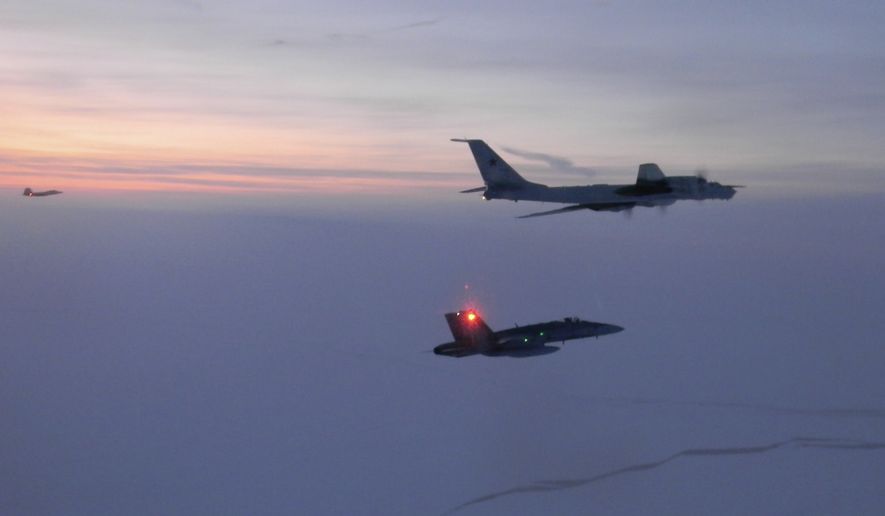ASPEN, Colo. — Two Russian maritime patrol aircraft tested the U.S. and Canadian air defense zone two weeks ago in a show of force in the midst of Moscow’s military operation in Ukraine and nuclear saber-rattling, the commander of the Northern Command said Friday.
Air Force Gen. Glen D. VanHerck, Northcom chief and also head of the U.S.-Canadian North American Aerospace Defense (NORAD) Command, said the recent intrusion was less provocative than past incidents involving nuclear-capable Russian bombers.
Nuclear tensions between the United States and Russia were raised following Moscow’s invasion of Ukraine, with Russian President Vladimir Putin and top aides raising the threat of a nuclear response as the U.S. and NATO moved to support and arm Kyiv.
Navy Capt. Pamela Kunze, a Northcom spokeswoman, said NORAD identified two Russian IL-38 maritime patrol aircraft flying near Alaska. One of the patrol aircraft entered the state’s air defense identification zone.
“NORAD tracked, identified and took appropriate action. The aircraft departed without incident,” Capt. Kunze said without elaborating.
An earlier incursion last year by two IL-38s resulted in the deployment of U.S. F-22 jets to intercept the turboprop aircraft.
Past Russian aerial intrusions involved nuclear-capable Tu-95 bomber formations that tested North American air defenses and monitored how American forces respond.
“What they were doing is just flying through the ADIZ,” Gen. VanHerck said of the recent incident during a meeting with reporters at the annual security conference held in Aspen, Col.
The Ilyushin IL-38 is a maritime patrol aircraft that is used for reconnaissance and for anti-submarine operations. Gen. VanHerck said flying strategic bombers in the midst of the Ukraine invasion could have been seen by the U.S. as “inadvertent escalation” and Moscow may have sought to avoid the misperception by dispatching the maritime patrol aircraft instead.
The Biden administration has also canceled a flight test of an intercontinental ballistic missile over concerns it might appear provocative at a time of rising tensions.
“But [the Russians] certainly use their maritime patrol aircraft,” the four-star general said. “There was nothing ongoing in the maritime domain for us for them to take a look at. So I think it was just an opportunity for them to exercise their flying.”
Russian strategic aircraft have been conducting flights near U.S. coasts for the past several years. Some of the flights involved provocative passages near California. Russia also announced that it had increased the alert level of its nuclear forces following the Ukraine invasion in February, although Pentagon officials have said there were no signs the forces were actually operating on a higher alert status.
Gen. VanHerck said that, overall, Moscow’s reconnaissance flights have not been “significantly out of the norm” this year.
The general is charged with homeland defense, which includes monitoring airspace for adversary aircraft and missiles, as well as the near seas for intelligence vessels known as AGIs, for “auxiliary general intelligence.”
So far this year, both Russian and Chinese naval reconnaissance activity has been limited, he said.
“I’m not tracking significant presence continually off of either coast from Russian AGIs,” Gen. VanHerck said.
Russian AGIs normally sail along the Atlantic coast and near the U.S. nuclear missile submarine base at Kings Bay, Georgia. The operations normally coincide with U.S. naval exercises or when Russian submarines are deployed to the Atlantic.
China also has been conducting what Gen. VanHerck called “aggressive” reconnaissance exercises mainly in the Pacific, the general said.
“Last year they sailed a task force in the region of the Aleutians,” he said.
Four Chinese warships were tracked by the Coast Guard in September. The task force included a guided-missile cruiser, a guided-missile destroyer, an AGI and an auxiliary ship.
The warships sailed within the U.S. exclusive economic zone but remained outside U.S. territorial waters from Aug 29 to Sept. 1.
The task force deployment followed a report in the Chinese Communist Party-affiliated Global Times that China’s military had dispatched the warships near U.S. territory in response to Navy “freedom of navigation” operations in the contested South China Sea.
Gen. VanHerck also noted Beijing’s ambitions toward the Arctic by sending an icebreaker to North America.
“Each of the last six years the Xue Long, the research ship that they talk about, has sailed into the Northcom [area of responsibility] and into the Arctic under the guise of doing scientific research,” he said. “Although they are also doing military studies, mapping the seabed for potential submarine operations.”
Gen. VanHerck also U.S. analysts are “keeping an eye on” Poseidon, Russia‘s planned new high-speed nuclear-armed drone torpedo, although he noted it has not been fielded yet. U.S. officials say the Poseidon, when deployed, will be equipped with a megaton-class nuclear warhead capable of destroying entire ports or cities.
Adm. John Aquilino, commander of the Indo Pacific Command, told Congress recently the Poseidon will be carried on a massive new special-purpose submarine, called the Belgorod, which is expected to be deployed this year.
Northcom and the U.S. military plan to counter the drone torpedo through anti-submarine efforts and close monitoring of Russian submarine deployments, soon to be enhanced by artificial intelligence, Gen. VanHerck said.
“Shooting a torpedo under the water is a significant challenge,” he said. “But, candidly, where I would rather go would be to deter them before … they get closer to the homeland.”
Advanced military artificial intelligence and machine-learning tools will provide commanders like Gen. VanHerck with “decision space” that could detect submarines carrying Poseidon torpedoes before they sail.
Gen. VanHerck said the military is working to strengthen homeland defenses against rising cruise, ballistic and hypersonic missile threats from both China and Russia. The command also is working to develop area defenses, including in the D.C. area and East Coast, against cruise and other missile threats.
• Bill Gertz can be reached at bgertz@washingtontimes.com.




Please read our comment policy before commenting.